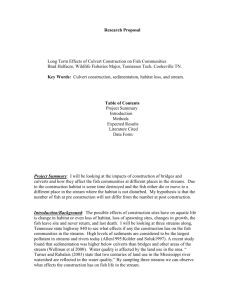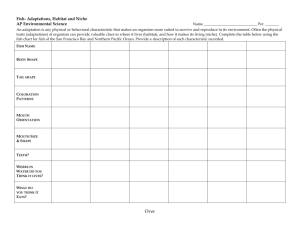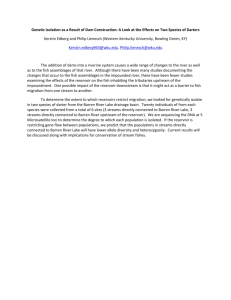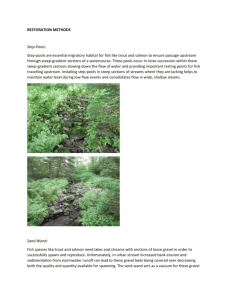Fish Assemblages: The Influence of Habitat and Hydrology Erika C Martin 1
advertisement
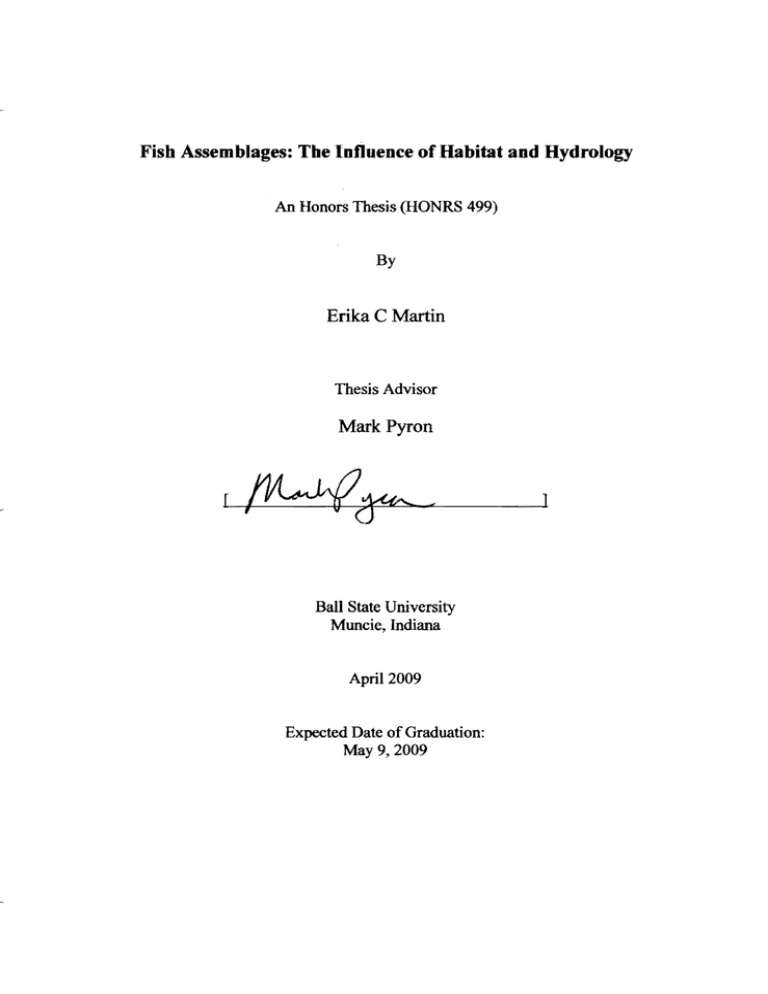
Fish Assemblages: The Influence of Habitat and Hydrology
An Honors Thesis (HONRS 499)
By
Erika C Martin
Thesis Advisor
Mark Pyron
1
Ball State University
Muncie, Indiana
April 2009
Expected Date of Graduation:
May 9, 2009
Fish Assemblages: The Influence of Habitat and Hydrology
2
Fish Assemblages: The Influence of Habitat and Hydrology
3
4
5
6
7
8
9
Erika C. Martin, Jayson Beugly and Mark Pyron*
10
Department of Biology, Ball State University, Muncie, IN 47306
11
12
13
14
15
16
17
18
Keywords: agriculture, streams, fish assemblages, hydrology
19
20
Running Head: Fish Assemblages: The Influence of Habitat and Hydrology
21
22
23
24
*coffesponding author mpyron@bsu.edu
Martin et 01.
1
Abstract
2
Rivers and streams are irreplaceable resources for both human
3
consumption and recreation. Disturbances of these ecosystems can lead to
4
degradation of part, or aU, of the stream system. Alteration of habitat influences
5
and changes the fauna within that environment. We sampled agricultural,
6
headwat€f intermittent and perennid streams in the White Riv€f watershed in
7
Delaware County in East-Central Indiana. We sampled 16 sites in May of 2007
8
using backpack electrofishing. Fish were identified and we assessed the response
9
of fish assemblages and identified relationships in fish abundance and diversity
10
with stream habitat and hydrology. We hypothesized tolerant fish species and
11
lower species richness would characterize both agricultural and intermittent
12
streams. We tested for a relafionship and interactlons among fish assemblages
13
with habitat and hydrological variables.
Fish Assemblages: The Influence of Habitat and Hydrology
Introduction
I
2
Clean water is a vital human amenity as freshwaters are frequently used as
3
drinking water sources and for recreational venue (Carpenter et 01. 1998). Streams are
4
fundamental components of these resources. They compose over two-thirds of total
5
available freshwater (Freeman et 01. 2007) and can exhibit high species diversity and
6
productivity. Human disturbances of these ecosystems can lead to poor water quality
7
(Le., decreased diversity and aesthetic value) and decrease the utility of these assets
8
for humans (Carpenter et 01. 1998).
9
Disruption of surrounding landscapes of a stream directly affects water quality
10
and stream habitat and indirectly affects organism biodiversity (Lammert and Allan
11
1999, Allan 2004, Harding et al. 1998). Land-use practices frequently influence stream
12
habitat and hydrology (Poff 1997, Harding et. al 1998, Lammert and Allan 1999, Scott
13
and Hall 1997, Stewart et. 012001, Allan 2004. Carpenter et al. 1998). Agricultural
14
adivities can yield broad alterations in landscapes through tile drainage and channel
15
modifications (Allan 1995, Carpenter et at 1998. Quinn et al. 1997) that cause diffuse
16
nutrient and sediment pollution (Lammert and Allan 1999, Carpenter et al. 1998. Stewart
17
et al. 2001. Plantinga 1996). Cascading events may further alter stream habitat through
18
decreased stabilization of the existing channel. These habitat changes in response to
19
agricultural activities may alter fish communities. For example. Harding et al. (1998)
20
documented that fish in agricultural streams that occupy the streambed were replaced
21
by more tolerant species that use the water column. Marchetti and Moyle (2001) also
22
identified numerous effects of agricultural activity on streams caused by altered flow
23
regimes including changes in channel structure, sediment transport, species diversity.
Martin et al.
2
Fish Assemblages: The Influence of Habitat and Hydrology
and community composition. Alterations affect the aquatic biota {Osmundson et al.
2
2002)and these changes alter the natural flow regime which is critical for fish
3
assemblage structure. Fish assemblages are robust indicators of water quality because
4
they react and change in abundance or occupancy with the surrounding environment
5
(Scott and Hall 1997).
6
Intermittent stream community compositions vary greatly due to physio-chemical
7
variation caused by decreased flow conditions (Closs and Lake 1994) and this
8
dependence on chemical conditions is amplified by agricultural inputs. Closs and Lake
9
(1994) defined intermittent streams as streams that cease to flow on a regular and
10
predictable basis. Fish become concentrated in pools when flow decreases and water
11
recedes in association with intermittent flow (Capone and Kushlan 1991, Labbe and
12
Fausch 2000). As pool depth, pool persistence, and channel size increase in intermittent
13
streams, species richness increases (Capone and Kushlan 1991). In contrast, perennial
14
streams have constant and predictable flow patterns and biota abundance and
15
richness increase with permanent flow (Closs and Lake 1994). Flow consistency is a
16
determining factor in severity of physio-chemical alterations, and agricultural runoff is
17
likely less concentrated and carried downstream rather than becoming concentrated
18
in stream pools when flow is more permanent as in perennial streams.
19
We studied headwater streams in an East-Central Indiana watershed dominated
20
by agriculture to assess the response of fish assemblage abundance and diversity
21
patterns with stream habitat and hydrology. We hypothesized tolerant fish species and
22
lower species richness would characterize both agricultural and intermittent streams.
23
We predicted differences between row crop and pasture agriculture sub-watersheds
24
based on differences in water chemistry and physical habitat, and differences among
Martin et a\.
3
Fish Assemblages: The Influence of Habitat and Hydrology
perennial and intermittent streams due to flow variation. We tested for a relationship for
2
fish assemblages with habitat and hydrological variables.
3
4
Study Sites
5
We sampled 15 agricultural headwater streams located in the Buck Creek
6
watershed, a tributary of the East Fork White River, within Delaware and Henry counties
7
in east central Indiana (Figure 2) in May of 2006. Streams were < 2 m wide, classified as
8
either intermittent or perennial, and as row crop agriculture or pasture. We found high
9
variation among sites for physical and chemical variables (Table 1).
10
11
Methods
Sites were selected based on flow (intermittent or perennial) and agriculture
12
(pasture or row-crop, Figure 1). All sites were headwater (first/second order) streams.
13
We quantified water quality at each site as pH, dissolved oxygen, conductivity, and
14
temperature using a portable Hydrolab. A Headwater Habitat Evaluation Index (HHEI)
15
score was created for each site. This index summarizes habitat characteristics of
16
substrate, maximum pool depth, bank full width, riparian zone and floodplain quality,
17
flow regime, sinuosity, and stream gradient. Flow was calculated at three locations on
18
each stream using a Marsh-Mcbirney flowmeter, with three replicates for each segment
19
for a total of nine flow values. We used mean flow in our analyses. Distance from Buck
20
Creek was quantified using Google Earth online software to quantify stream distance
21
from each site to its convergence with Buck Creek.
Martin et al.
4
Fish Assemblages: The Influence of Habitat and Hydrology
Fish were collected in l00-m reaches using single-pass electro-fishing once in
2
early spring with two netters. Most fish were identified in the field, except for
3
questionable individuals that were preserved in 70% alcohol and later identified in the
4
laboratory.
5
Data Analysis
6
We used Canonical Correspondence Analysis (CCA (PC-ORD, McCune and
7
Mefford 1999) to examine fish and habitat relationships. CCA is a direct gradient
8
analysis that assesses the strength of the environmental variables relationships to
9
species composition. The CCA options we used were, row and column scores
10
standardized by centering and normalizing, ordination scores scaled to optimize rows,
1I
site scores linear combinations of variables, and a Monte Carlo test of significance with
12
100 randomizations tested for significant differences from a randomization. Two sample
13
t-tests were run to test for differences in agriculture and flow type. Species richness was
14
calculated for all sites (Figure 3). Shannon- Weiner index of diversity was calculated for
15
each site based on agriculture type (Figure 4) and flow pattern [Figure 5).
16
Results
17
We captured 13 species during electro-fishing. The most abundant were mottled
18
sculpin, creek chub, and blacknose dace (Table 2). Species richness ranged from 0 - 9
19
species per site with a mean of four. The mean site depth was 0.2 m, mean flow was 0.3
20
ft/s, and mean site distance from Buck Creek was 1,300 m.
21
Ordination
Martin et al.
5
Fish Assemblages: The Influence of Habitat and Hydrology
Three Canonical Correspondence Analysis axes explained a total of 53.3% of
2
total variation in species abundances among sites (28.8, 12.8, and 11.7%, respectively).
3
All axes were significantly different from randomly generated axes in Monte Carlo
4
analyses (P < 0.05). Environmental gradients driving the first axis include HHEI score and
5
site distance from Buck Creek, whereas gradients in agriculture type and site distance
6
from Buck Creek were strong on the second and third axes [Figures 6 and 7}. Axis 1 was
7
primarily driven by HHEI scores and distance of the site from Buck Creek.
8
Brook stickleback, blackside darter, green sunfish, and brook lamprey were in
9
higher abundance at sites further distant from Buck Creek (Figure 6). Mottled sculpin
10
and blacknose dace occurred at sites with higher HHEI scores (Figure 6). The second
11
CCA axis was based primarily on site distance and agriculture type, either row crop or
12
pasture. Stoneroller and White Sucker had highest abundances at pasture sites and
13
orangethroat darter occurred at row crop sites. CCA Axis 3 was an axis of site distance
14
and agriculture type (row crop/ pasture). Bluegill and green sunfish occurred in higher
15
abundance at pasture sites. Stoneroller, Brook stickleback, and orangethroat darter
16
occurred at highest abundances at sites farther from Buck Creek (Figure 7).
17
Discussion
18
The results of this study suggest support previous theories that agricultural
19
activities alter the biological and habitat integrity of streams (Allan et a!. 1997).
20
Agricultural sites had lower fish diversity than expected. Similar results were obtained in
21
the study by Townsend et al. (1997) of land use effects on aquatic vegetative
22
morphology and macroinvertebrate communities in which they found pasture streams
Martin et al.
6
Fish Assemblages: The Influence of Habitat and Hydrology
had low representation of endemic plant species. Human land-use activities frequently
2
have negative impacts on water quality and aquatic biota (Freeman et al. 2007).
3
We found slight differences in fish abundance and distribution in relation to
4
pasture or row-crop agriculture from the ordination; however t-tests did not support
5
these findings. Although the Stoneroller and White Sucker had highest abundances at
6
pasture sites and orangethroat darter occurred at row crop sites (Figure 6), results do
7
not support a significant relationship. The two site types were scattered in the CCA
8
ordinations with no distinct pattern. We predicted differences in species composition
9
and abundance based on agricultural practices that have different effects on in-
10
stream habitat. We did not find significant differences between agriculture types, our
11
results may be due to site locations as they are close in proximity. Also, if both
12
agriculture practices severely impacted the streams then biodiversity would be
13
decreased throughout the sites, which is true for these streams. For example, if sediment
14
loading and turbidity were unusually high, this would limit the amount and types of
15
species that could survive there. This explains the very low species abundances and
16
diversity.
17
Our prediction of differences between row crop and pasture agriculture
18
practices, and intermittent and perennial streams were not supported by the data. This
19
is also likely due to low species diversity and abundances at all sites. By increasing the
20
number of sites and sampling longer stream reaches, we would be able to more fully
21
understand and interpret the similarities and differences among these land-use and
22
flow gradients.
23
Martin et al.
7
Fish Assemblages: The Influence of Habitat and Hydrology
Conclusion
2
HHEI score, agriculture type, and site distance provided strong explanation of
3
the species abundance patterns in the CCA analysis. Human alterations from
4
agriculture affect riparian zone quality, hydrological variables !e.g., depth), and
5
substrate. These alterations affect species abundance and diversity, which were low
6
across these sites. The habitat evaluation score (HHEIJ quantifies these variables and
7
provided a significant explanation of variation in species composition suggesting a
8
relationship among these variables and fishes. Agriculture type was also a primary
9
driver, and our ordination results suggested a difference in species composition
10
between row crop and pasture agricultural streams, however t-test results were not
1J
significant. Site distance from Buck Creek was a strong explanatory variable for all axes
J2
and species composition at our sites. Streams adjacent to Buck Creek tended to be
J3
larger and had higher flow, and streams further distant tended to be smaller and
J4
shallow with decreased flow.
J5
The Buck Creek watershed has a low elevation gradient. Sites are homogenous
16
in elevation and it is not considered an imperative factor. The variation in fish
J7
communities then could be due to the differences in stream size, point/non-point
18
pollution, surrounding land use, channel modification, or in-stream blockage such as
19
dams or large sediment deposits. We conclude that these agriculturally impacted
20
headwater stream fish assemblages are simple and structured by stream habitat and
21
quality. From a management perspective, in order to have successful fisheries we
22
recommend a program to monitor stream and water quality.
23
Acknowledgements: We thank A. Umberger for help in the field.
Martin et al.
8
Fish Assemblages: The Influence of Habitat and Hydrology
Table 1: Ranges of stream variables.
2
Variable
3
4
Martin et 01.
I
Range
Depth (m)
0-0.251
Distance (m)
79-3240
Temperature °C
10.45-17.61
Species richness
0-9
Conductivity
311-752
Dissolved oxygen (mg/I)
6.65-16.85
pH
7.58-8.51
Flow (ft/sec)
0-0.97
HHEI score
49-76
Abundant Substrate
Silt
9
Fish Assemblages: The Influence of Habitat and Hydrology
Table 2: Species abundances.
2
Species
3
Total # Individ.
Mottled Sculpin
309
Creek Chub
138
Blacknose Dace
114
Orangethroat Darter
60
Green Sunfish
45
Central Stoneroller
36
Bluegill
30
Brook Stickleback
19
White Sucker
19
Brook Lamprey
3
Blackside Darter
3
Common carp
2
Largemouth bass
1
I
Martin et 01.
10
Fish Assemblages: The Influence of Habitat and Hydrology
Figure 1: Site in cow pasture.
2
Figure 2: Location of study sites.
3
Figure 3: Species richness per site.
4
5
Figure 4: Shannon-Weiner diversity by site. Green bars indicate pasture sites and black
6
7
Figure 5: Shannon-Weiner diversity by site. Blue indicates an intermittent stream, black
8
9
10
11
12
13
bars indicate row crop agriculture.
indicates a perennial stream.
Figure 6: First and second axis from CCA analysis. Arrow lengths represent the strength
of environmental variables with the canonical axes. Red squares are fishes and black
circles are sites.
Figure 7: Canonical Correspondence Analysis. Axes 1 and 3. Axis 3 is primarily driven by
site distance from Buck Creek and agriculture type [Row Crop/ Pasture).
Martin et aL
11
Fish Assemblages: The Influence of Habitat and Hydrology
1
2
Figure 1:
•
•
Martin et 01.
12
Fish Assemblages: The Influence of Habitat and Hydrology
Figure 2:
2
Martin et al.
13
Fish Assemblages: The Influence of Habitat and Hydrology
Figure 3:
2
-------------------- --------------------------------~
Species Richness
10 ~--------------------------------------~
U)
(i)
(.)
8 +--------- - - 6
~ 4
=It:
2
U)
o
2
3
4
5
6
7
8
9
10 11
12 13 14 15 16
site
Martin et 01.
14
Fish Assemblages: The Influence of Habitat and Hydrology
Figure 4:
2
Species Diversity
3
Row Crop/Pasture
4
5
6
7
8
--
~
G)
c:::
"a;
G)
~
3:• ~ 4
3c:::
0 ><
G)
c::: "t:J 2
c:::
1
CI c:::
J:
U)
9
o2
10
3
4
5
6
7
--
- 8
9
10 11
-
--
12 13 14 15 16
Site
11
12
Martin et al.
15
Fish Assemblages: The Influence of Habitat and Hydrology
Figure 5:
2
3
Species Diversity
Inte rm itte nt/Pe re n nial
4
5
6
7
...
6
CI.)
c:
~
:::J
I
~
0
)(
CI.)
c:
4
8
c: "C
c: c:
2
9
.c
o
'"
CI)
-2
10
3
4
--
-
CI.)
-
-5
6
7
8
9
10
11
12
13
14
15
16
Site
11
12
13
14
Martin et 01.
16
Fish Assemblages: The Influence of Habitat and Hydrology
Figure 6:
2
2
3
4
1
5
9
Gre:
. , Iuegill
HHEI
sun
Brk stick Ie
rook lamprey
•
sdarter Site Distance
6
7
White sucker
•
-1
8
9
-2
10
5 neroller
•
-3
11
-2
12
-1
o
1
Axis 1
2
3
4
13
14
Martin et al.
17
Fish Assemblages: The Influence of Habitat and Hydrology
Figure 7:
2
2
3
1
9
Gre: sun
ei 'Uegill
HHEI
Brkstic kle
rook lamprey
•
sdarter Site Distance
N
·W
cC
White sucker
•
-1
-2
5 nerol/er
•
-3
-2
Martin et al.
-1
a
1
Axis 1
2
3
4
18
Fish Assemblages: The Influence of Habitat and Hydrology
References
2
3
4
5
6
7
8
9
Allan, J. David. "Landscapes and Riverscapes: The Influence of Land Use on Stream
Ecosystems." Annual Review of Ecology, Evolution, and Systematics 35{2004J : 257284.
Allan, J. David, Donna L. Erickson, and John Fay. liThe influence of catchment land use
on sfream integrity across multip1e spatial sca1es" . Freshwater Biology. 37( 1997}:
149-161.
10
Carpenter, S.R., N.F. Caraco, D.L. Correll, and R.W. Howarth, A.N. Sharpley, and V.H.
Smith. "Non point Pollution of Surface Waters with Phosphorus and Nitrogen."
Ecology. 8{ 1998}: 559-568.
11
12
Closs, G.P., and P.S. Lake. "Spatial and Temporal Variation in the structure of an
Intermittent-Stream Food Web." Ecological Monographs 64( 1994): 1-21.
13
14
Freeman, Mary c., Catherine M. Pringle, and C. Rhett Jackson. "HydrologiC
Connectivity and the Contribution of Stream Headwaters to Ecological Integrity
at Regional Scales." Journal of the American Water Resources Association
15
16
43(2007): 5-14.
17
18
Harding, J.S., E.F. Benfield, P.V. Bolstad, and G.S. Helfman, and E.BD. Jones III. "Stream
Biodiversity: The Ghost of Land Use Past." Ecology. 95( 1998): 14843-14847.
19
20
21
Labbe, Theodore R., and Kurt D. Fausch. "Dynamics of Intermittent Stream Habitat
Regulate Persistence of a Threatened Fish at Multiple Scales." Ecological
Applications 10(2000}: 1774-1791.
22
23
24
Lammert, Mary, and J. David Allan. "Assessing Biotic Integrity of Streams: Effects of Scale
in Measuring -the Influence of Land Use/Cover and Habitat Structure on Fish and
Macroinvertebrates." Environmental Management 23(1999}: 257-270.
25
26
Marchetti, Michael P., and Peter B. Moyle. "Effects of Flow Regime on Fish Assemblages
in a Regulated California Stream." Ecological Applications 11 [2001} : 530-539 .
27
28
McCune B., and M. J. Mefford. 1999. PC-ORD: Multivariate Analysis of Ecological
Data Version 4.20. MjM Software, Gleneden Beach, Oregon.
29
30
31
Osmundson, D. B., R.J. RyeL V.L. Lamarra, and J. Pitlick. "Flow-Sediment-Biota Relations:
Implications for River Regulation Effects on Native Fish Abundance." Ecological
Applications 12[2002}: 1719-1739.
32
33
Plantinga, Andrew J.. 'The Effect of Agricultural Policies on Land Use and Environmental
Quality." American Journal of Agricultural Economics 78(1996}: 1082-1091.
Martin et a!.
19
Fish Assemblages: The Influence of Habitat and Hydrology
2
3
4
5
6
7
Poff, N. LeRoy. "Landscape Filters and Species Traits: Towards Mechanistic
Understanding and Prediction in Stream Ecology." Journal of North American
Benthological Society 16(1997): 391-409.
Quinn, John M., A. Bryce Cooper, Robert J. Davies-Colley, and J. Christopher Rutherford
and R. Bruce Williamson. "Land use effects on habitat, water quality, periphyton,
and benthic invertebrates in Waikato, New Zealand, hill-country streams." New
Zealnd Journal of Marine and Freshwater Research. 31 (1997): 579-597.
8
9
10
Scott, Mark C ., and Lenwood W. Hall, Jr.. "Fish Assemblages as Indicators of
Environmental Degradation in Maryland Coastal Plain Streams." Transactions of
the American Fisheries Society 126( 1997): 349-360.
11
12
13
14
Stewart, Jana S., Lizhu Wang, John Lyons, and Judy A. Horwatich, and Roger
Bannerman. "Influences of Watershed, Riparian-Corridor, and Reach-Scale
Characteristics on Aquatic Biota in Agricultural Watersheds." Journal of the
American Water Resources Association. 37(2001): 1475-1487.
15
16
17
18
Townsend, Colin R., Barbara J. Downes, Kathi Peacock, and Chris J. Arbuckle. "Scale
and the detection of land-use effects on morphology, vegetation, and
macroinvertebrate communities of grassland streams." Freshwater Biology.
49(2004):448-462).
Martin et al.
20
